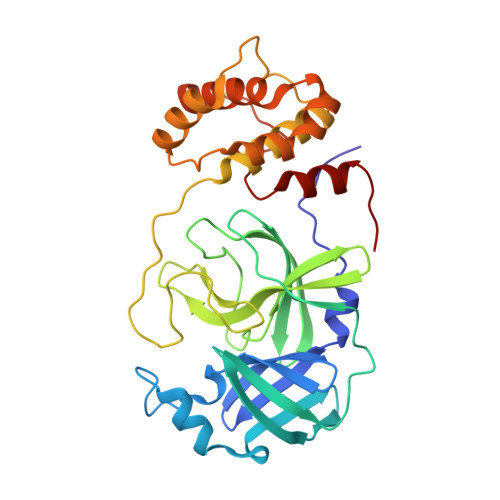Silaproline-bearing nirmatrelvir derivatives are potent inhibitors of the SARS-CoV-2 main protease highlighting the value of silicon-derivatives in structure-activity-relationship studies.
Laczi, D., Huaman, S.S., Andrews-Clark, T., Laidlaw, S.M., Salah, E., Dumjahn, L., Lukacik, P., Choudhry, H., Walsh, M.A., Carroll, M.W., Schofield, C.J., Brewitz, L.(2025) Eur J Med Chem 291: 117603
- PubMed: 40220677
- DOI: https://doi.org/10.1016/j.ejmech.2025.117603
- Primary Citation of Related Structures:
9H0F - PubMed Abstract:
Nirmatrelvir is a substrate-related inhibitor of the severe acute respiratory syndrome coronavirus-2 (SARS-CoV-2) main protease (M pro ) that is clinically used in combination with ritonavir to treat COVID-19. Derivatives of nirmatrelvir, modified at the substrate P2-equivalent position, have been developed to fine-tune inhibitor properties and are now in clinical use. We report the synthesis of nirmatrelvir derivatives with a (R)-4,4-dimethyl-4-silaproline (silaproline) group at the P2-equivalent position. Mass spectrometry (MS)-based assays demonstrate that silaproline-bearing nirmatrelvir derivatives efficiently inhibit isolated recombinant M pro , albeit with reduced potency compared to nirmatrelvir. Investigations with SARS-CoV-2 infected VeroE6 cells reveal that the silaproline-bearing inhibitors with a CF 3 group at the P4-equivalent position inhibit viral progression, implying that incorporating silicon atoms into M pro inhibitors can yield in vivo active inhibitors with appropriate optimization. MS and crystallographic studies show that the nucleophilic active site cysteine residue of M pro (Cys145) reacts with the nitrile group of the silaproline-bearing inhibitors. Substituting the electrophilic nitrile group for a non-activated terminal alkyne shifts the inhibition mode from reversible covalent inhibition to irreversible covalent inhibition. One of the two prochiral silaproline methyl groups occupies space in the S2 pocket that is unoccupied in M pro :nirmatrelvir complex structures, highlighting the value of sila-derivatives in structure-activity-relationship (SAR) studies. The combined results highlight the potential of silicon-containing molecules for inhibition of M pro and, by implication, other nucleophilic cysteine enzymes.
- Chemistry Research Laboratory, Department of Chemistry and the Ineos Oxford Institute for Antimicrobial Research, University of Oxford, 12 Mansfield Road, OX1 3TA, Oxford, UK.
Organizational Affiliation:





















